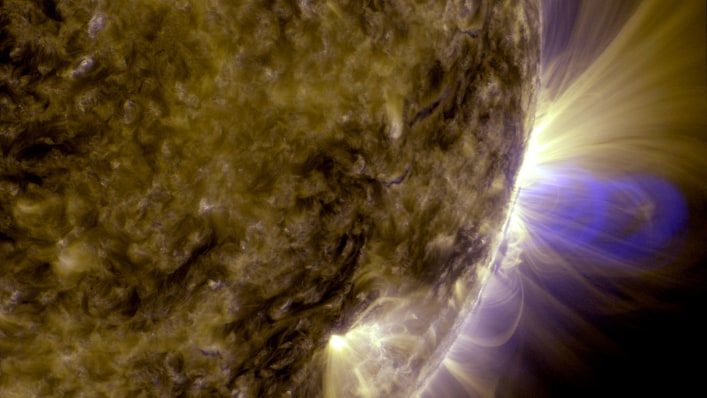
© NASA/Goddard Space Flight Center/SDO
The Space Weather Prediction Center has upgraded a
geomagnetic storm watch for September 6 and 7 to a level only occasionally seen, but scientists say it's nothing to be too alarmed about.
They do recommend looking for an unusual display of the aurora-the northern lights caused by a disturbance of the magnetosphere-in areas of the U.S. not used to seeing them.
"The big takeaway from this level of storming would be just
increased chance of seeing the aurora, really in the upper tier of the United States," says Robert Rutledge, lead of operations at the center, which is part of the National Oceanic and Atmospheric Administration. (Here's
an animation of the CME from NASA's Solar Dynamics Observatory.)
The storm could pose an
"elevated radiation risk to passengers & crew in high-flying aircraft at far north or south latitudes," a NOAA warning says, and intermittently impact high-frequency RF communications, which may require some transpolar flight routes to divert to lower geomagnetic latitudes (a shift that would cost the airlines more). But currently, says Rutledge, the
storm isn't expected to interfere with flights or any other human activity here on earth or in space. There's a slim chance of isolated interfere with high-precision GPS readings, but those issues usually only arise with stronger storms, he says.
The so-called G3 level storm is the result of what's called a
coronal mass ejection, where magnetic interactions on the sun launch part of its outer atmosphere of superheated plasma into space. When that burst of radiation gets near earth-barreling toward us at a million miles per hour, it
takes about two days to make the journey-its magnetic field interacts with Earth's, Rutledge says.
"The geomagnetic storm is a result of that process," he says. "That's what causes the auroras, where it's dumping energy into the atmosphere."
The sun's magnetic activity operates on a roughly 11-year cycle, and activity of this intensity takes place for about 100 total days of that cycle. But we're currently experiencing the downside of a not particularly strong solar activity cycle, so storms like this are not frequent. A similar magnitude storm was last seen in May, Rutledge says.
Northern U.S. and Canadian residents hoping to catch a glimpse of the aurora will get their best shot on Wednesday night and early Thursday, and the Space Weather Prediction Center posts
30-minute forecasts of the colorful sky phenomenon's intensity.
"It's a mid-range event, but if it's a chance to see the aurora in the northern tier of the lower 48, we'll certainly take it," Rutledge says.
Meanwhile, his agency's
National Hurricane Center is preparing for a far more dangerous storm: this week Irma is expected to bring catastrophic winds and potential storm surges to the U.S. Virgin Islands, Puerto Rico, Dominican Republic, the Florida Keys, and the UK territory of Turks and Caicos.

Reader Comments
to our Newsletter